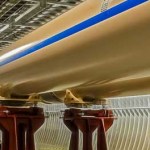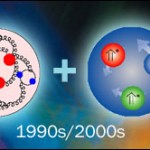nuclear physics
Theoretical physicist Raju Venugopalan
We sat down with Brookhaven theoretical physicist Raju Venugopalan for a conversation about “color glass condensate” and the structure of visible matter in the universe.
Q. We've heard a lot recently about a "new form of matter" possibly seen at the Large Hadron Collider (LHC) in Europe — a state of saturated gluons called “color glass condensate.” Brookhaven Lab, and you in particular, have a long history with this idea. Can you tell me a bit about that history?
A. The idea for the color glass condensate arose to help us understand heavy ion…
RHIC, the Relativistic Heavy Ion Collider at Brookhaven Lab, found it first: a “perfect” liquid of strongly interacting quarks and gluons – a quark-gluon plasma (QGP) – produced by slamming heavy ions together at close to the speed of light. The fact that the QGP produced in these particle smashups was a liquid and not the expected gas, and that it flowed like a nearly frictionless fluid, took the physics world by surprise. These findings, now confirmed by heavy-ion experiments at the Large Hadron Collider (LHC) in Europe, have raised compelling new questions about the nature of matter and…
Several people blogged about a new measurement of gravitational states of neutrons done by physicists using ultracold neutrons from the Institut Laue-Langevin in France. I had to resort to Twitter to get access to the paper (we don't get Nature Physics here, and it's way faster than Inter-Library Loan), but this is a nice topic for a ResearchBlogging post, in the now-standard Q&A form:
OK, why was this worth begging people on Twitter to send you a copy? The paper is a demonstration of a sort of spectroscopy of neutrons bouncing in a gravitational field. They showed they could drive…
Most of what would ordinarily be blogging time this morning got used up writing a response to a question at the
Physics Stack Exchange. But having put all that effort in over there, I might as well put it to use here, too...
The question comes from a person who did a poster on terminology at the recently concluded American Geophysical Union meeting, offering the following definition of "data":
Values collected as part of a scientific investigation; may be qualified as 'science data'. This includes uncalibrated values (raw data), derived values (calibrated data), and other transformations of…
This is the first in an occassional series about Brookhaven's Relativistic Heavy Ion Collider, or, as it's affectionately called, RHIC.
Lil John has a theme song for RHIC's latest experimental run.
Sorry, sorry! I couldn't resist. RHIC's actual ditty of the moment goes more like this. (Clean version, of course, RHIC doesn't want any soap in its linac).
RHIC, which has a maximum potential energy of 200 billion electron volts (GeV), collided gold ions at energies as low as 7.7 GeV this spring -- the lowest ever achieved in the machine. But why go so low?
Even at low energies, the gold-gold…
The big physics story at the moment is probably the new measurement of the size of the proton, which is reported in this Nature paper (which does not seem to be on the arxiv, alas). This is kind of a hybrid of nuclear and atomic physics, as it's a spectroscopic measurement of a quasi-atom involving an exotic particle produced in an accelerator. In a technical sense, it's a really impressive piece of work, and as a bonus, the result is surprising.
This is worth a little explanation, in the usual Q&A format.
So, what did they do to measure the size of a proton? Can you get rulers that small…
Where can scientists collide gold ions at close to the speed of light; take photos of some of the smallest materials known to humans; decipher the structure of proteins vital to everyday life; illuminate the brains of drug and food addicts; and test materials developed for fuel cells and other clean energy technologies - all on one campus?
These things happen every day at Brookhaven National Laboratory, a (very) multidisciplinary, government-funded institution located on Long Island, about 60 miles east of New York City.
Every year, more than 5,000 researchers from around the world join the…

